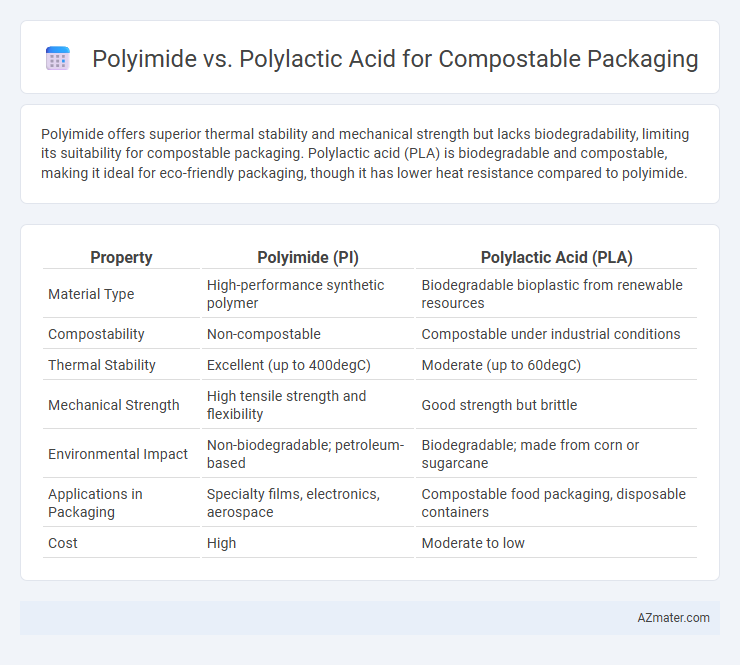Polyimide offers superior thermal stability and mechanical strength but lacks biodegradability, limiting its suitability for compostable packaging. Polylactic acid (PLA) is biodegradable and compostable, making it ideal for eco-friendly packaging, though it has lower heat resistance compared to polyimide.
Table of Comparison
| Property | Polyimide (PI) | Polylactic Acid (PLA) |
|---|---|---|
| Material Type | High-performance synthetic polymer | Biodegradable bioplastic from renewable resources |
| Compostability | Non-compostable | Compostable under industrial conditions |
| Thermal Stability | Excellent (up to 400degC) | Moderate (up to 60degC) |
| Mechanical Strength | High tensile strength and flexibility | Good strength but brittle |
| Environmental Impact | Non-biodegradable; petroleum-based | Biodegradable; made from corn or sugarcane |
| Applications in Packaging | Specialty films, electronics, aerospace | Compostable food packaging, disposable containers |
| Cost | High | Moderate to low |
Introduction to Polyimide and Polylactic Acid
Polyimide is a high-performance polymer known for its exceptional thermal stability, mechanical strength, and chemical resistance, making it suitable for demanding industrial applications rather than compostable packaging. Polylactic Acid (PLA), derived from renewable resources like corn starch or sugarcane, is a biodegradable aliphatic polyester widely used in compostable packaging due to its ability to break down under industrial composting conditions. PLA offers a sustainable alternative with lower carbon footprint compared to conventional plastics, whereas polyimide's properties are not conducive to compostability or environmental degradation.
Chemical Composition and Structure
Polyimide features a robust aromatic polyimide backbone characterized by imide linkages, delivering exceptional thermal stability and chemical resistance ideal for durable packaging applications. Polylactic acid (PLA) consists of aliphatic polyester chains derived from renewable lactic acid monomers, which facilitate biodegradability and compostability under industrial composting conditions. The chemical structure of PLA contains ester linkages susceptible to hydrolysis, contrasting with the inert imide bonds in polyimide, making PLA preferable for environmentally-friendly, compostable packaging solutions.
Sustainability and Environmental Impact
Polyimide offers high thermal stability and chemical resistance but is non-biodegradable, limiting its sustainability for compostable packaging. Polylactic Acid (PLA), derived from renewable resources like corn starch, provides a biodegradable and compostable alternative, significantly reducing environmental impact by breaking down into non-toxic components in industrial composting conditions. PLA's lower carbon footprint and compatibility with existing composting infrastructure make it a preferred choice for eco-friendly packaging solutions.
Biodegradability and Compostability
Polyimide is a high-performance polymer known for its thermal stability and chemical resistance but lacks biodegradability and compostability, making it unsuitable for eco-friendly packaging. Polylactic Acid (PLA), derived from renewable resources like corn starch, offers excellent biodegradability and compostability under industrial composting conditions, breaking down into water, carbon dioxide, and biomass within 90 to 180 days. PLA's compostability aligns with global sustainability goals, whereas polyimide's persistence in the environment limits its use in compostable packaging applications.
Mechanical and Barrier Properties
Polyimide exhibits superior mechanical strength and thermal stability compared to Polylactic Acid (PLA), making it suitable for applications requiring durability and heat resistance in packaging. However, PLA provides excellent biodegradability and compostability with moderate mechanical properties but faces limitations in moisture and oxygen barrier performance. Enhancing PLA's barrier properties through coatings or blending can improve its functionality for compostable packaging while maintaining environmental benefits.
Manufacturing Processes and Scalability
Polyimide requires complex high-temperature synthesis and specialized curing processes, limiting its scalability for compostable packaging due to high energy consumption and production costs. In contrast, polylactic acid (PLA) is derived from renewable biomass and manufactured through scalable fermentation and polymerization methods, offering cost-effective mass production with lower environmental impact. The ease of PLA processing using conventional extrusion and molding equipment accelerates its adoption in sustainable packaging markets compared to the more intricate polyimide production workflow.
Cost Comparison and Market Availability
Polyimide, known for its high thermal stability and chemical resistance, is significantly more expensive than polylactic acid (PLA), with costs often limiting its use in compostable packaging applications. PLA, derived from renewable resources such as corn starch, is widely available in the market at a lower price point, making it the preferred choice for cost-sensitive compostable packaging solutions. Market availability favors PLA due to its established supply chains and scalability, whereas polyimide remains less accessible for large-scale compostable packaging due to higher production costs and limited suppliers.
Applications in Compostable Packaging
Polylactic acid (PLA) is widely used in compostable packaging due to its biodegradability and ability to break down in industrial composting environments, making it ideal for single-use containers, bags, and food packaging films. Polyimide, known for its thermal stability and chemical resistance, lacks compostability and is generally unsuitable for compostable packaging but finds applications in high-performance electronic and aerospace components. The main advantage of PLA in compostable packaging lies in its renewable sourcing from corn starch or sugarcane, aligning with environmental sustainability goals, unlike polyimide's synthetic and non-biodegradable nature.
Regulatory Compliance and Certifications
Polyimide, despite its excellent thermal stability and mechanical properties, generally lacks recognized certifications for compostable packaging such as ASTM D6400 or EN 13432, limiting its regulatory compliance in biodegradable markets. Polylactic Acid (PLA), derived from renewable resources, meets key compostability standards including ASTM D6400, EN 13432, and is widely accepted by regulatory bodies for industrial composting facilities. Regulatory compliance for compostable packaging prioritizes certifications like OK Compost, Seedling, and BPI, where PLA consistently maintains certification while polyimide does not, making PLA the preferred choice for sustainable packaging solutions.
Future Trends in Compostable Packaging Materials
Polyimide, known for its high thermal stability and mechanical strength, is less biodegradable compared to polylactic acid (PLA), which is derived from renewable resources and widely used in compostable packaging. Future trends emphasize the development of hybrid materials combining PLA's biodegradability with enhanced durability from synthetic polymers like polyimide to meet stricter environmental regulations. Innovations in bio-based additives and advanced polymer blends aim to improve compostability while maintaining performance in packaging applications.

Infographic: Polyimide vs Polylactic Acid for Compostable Packaging
 azmater.com
azmater.com